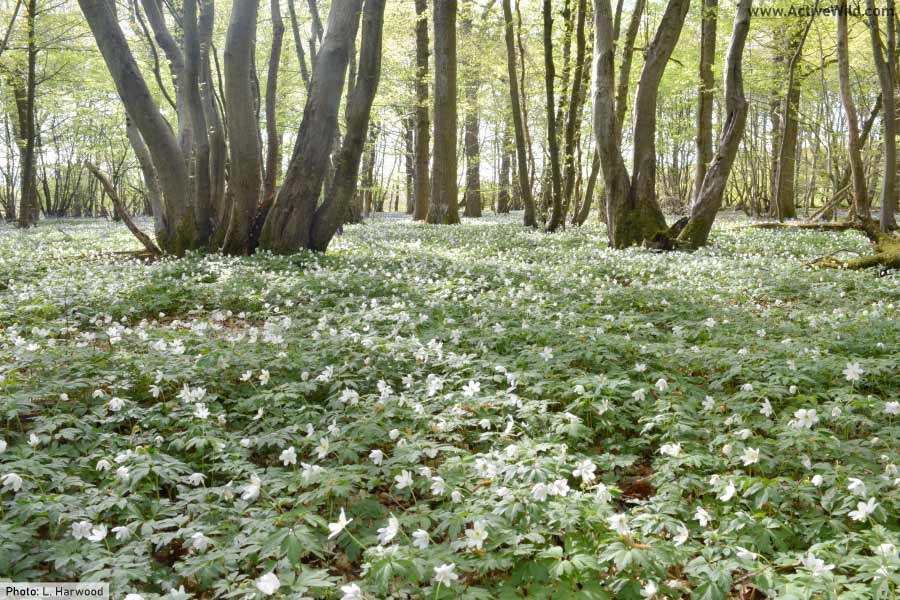
The world’s woodlands provide an important habitat for many different species. On this page is a list of woodland animals from all around the world, with pictures, facts, and links to further information.
Page Index
- Woodland Animals List
- What Is Woodland?
- Woodland Animals of North America
- Woodland Animals of Europe
- Woodland Animals of Africa
- Woodland Animals of Asia
- Woodland Animals of Australia
- Woodland Animals of South America
- Further Reading
Woodland Animals List
- Acorn Woodpecker
- African Civet
- African Forest Elephant
- African Wild Dog
- American Black Bear
- Asian Black Bear
- Capybara
- Chimpanzee
- Common Brushtail Possum
- Eastern Gray Squirrel
- Eastern Grey Kangaroo
- Eurasian Lynx
- European Badger
- European Hedgehog
- European Wild Boar
- Giant Anteater
- Great Spotted Woodpecker
- Indian Giant Squirrel
- Indian Peafowl
- Jaguar
- Japanese Serow
- Koala
- Laughing Kookaburra
- Leopard
- Northern Cardinal
- Raccoon
- Red Fox
- Scarlet Macaw
- Serval
- Tasmanian Devil
- White-Tailed Deer
- Wild Turkey
- Yellow-Footed Tortoise
What Is A Woodland?

A woodland is a terrestrial ecosystem characterized by a dense growth of trees, shrubs, and other vegetation. Woodlands differ from forests in terms of tree density, size, and canopy cover, with woodlands typically being more open, and having a less continuous canopy, than forests.
Woodlands are found in various regions across the globe, spanning different climate zones, such as temperate, boreal, and tropical, each of which having its own unique collection of woodland species.
Woodlands provide shelter and food for a wide variety of animals. They also play a crucial role in regulating water cycles, maintaining soil quality, and preventing erosion.
Below are examples of woodland creatures from all around the world. The IUCN Redlist conservation status provided for each species is correct as of May 2023.
Woodland Animals of North America
Acorn Woodpecker
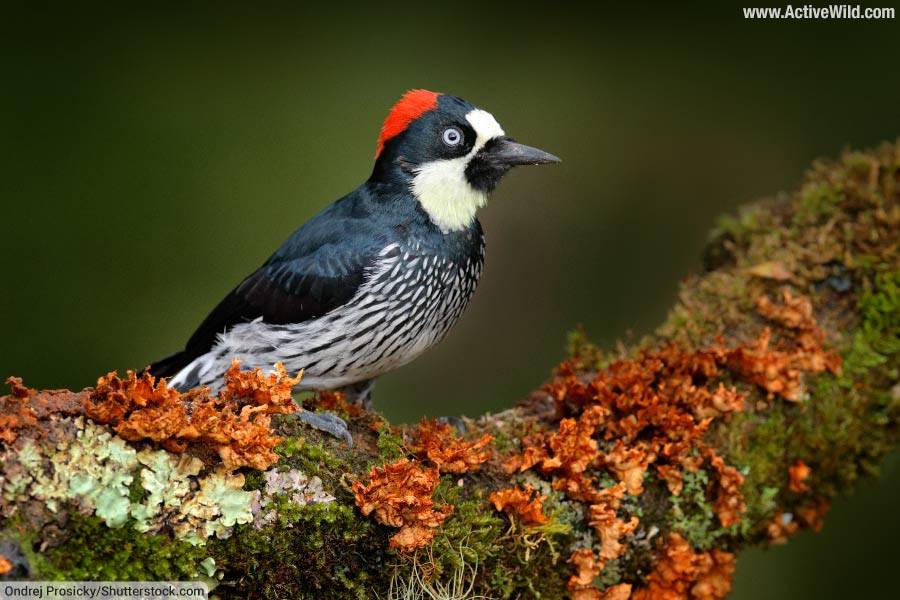
Scientific name: Melanerpes formicivorus
Family: Picidae
Where found: Western United States, Mexico, and Central America, in oak and pine-oak woodlands
Conservation status: Least Concern
The Acorn Woodpecker is a medium-sized woodpecker recognized by its striking black, white, and red facial pattern and streaked chest.
This woodland bird is known for its behavior of storing acorns in holes drilled into trees or wooden structures. These so-called “granaries” can house thousands of acorns and are used by multiple generations of Acorn Woodpeckers.
The Acorn Woodpecker has a strong bill, which is used for drilling holes and excavating insects from trees.
Acorn Woodpeckers are highly social birds, living in family groups with a cooperative breeding system, where multiple individuals help to raise the young. Their diet consists mainly of acorns, but they also consume insects, fruit, and nectar.
Discover More With Active Wild
You can find out more about birds on this page: Birds – The Ultimate Guide
Discover different types of birds on this page: Types of Birds
Test your knowledge of North American birds with our Android app: North American Bird ID Quiz for Android
American Black Bear
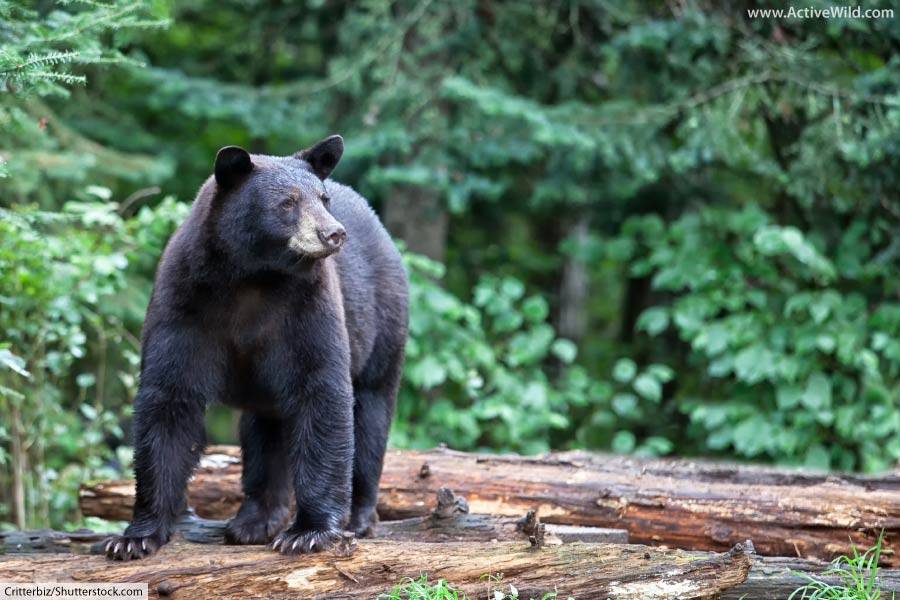
Scientific name: Ursus americanus
Family: Ursidae
Where found: North America, from Alaska to Mexico
Conservation status: Least Concern
The American Black Bear is the smallest and most widely-distributed bear species in North America. An omnivore, it has a diverse diet, consisting of plants, insects, fish, and mammals.
Equipped with sharper claws than the larger brown bear, the black bear is known for its excellent tree-climbing skills. It is primarily a solitary animal.
Discover More With Active Wild
You can find out more about bears on this page: Bears – The Ultimate Guide
Discover all eight types of bear on this page: Types of Bears
You can see more omnivorous animals on this page: Examples of Omnivores
Eastern Gray Squirrel
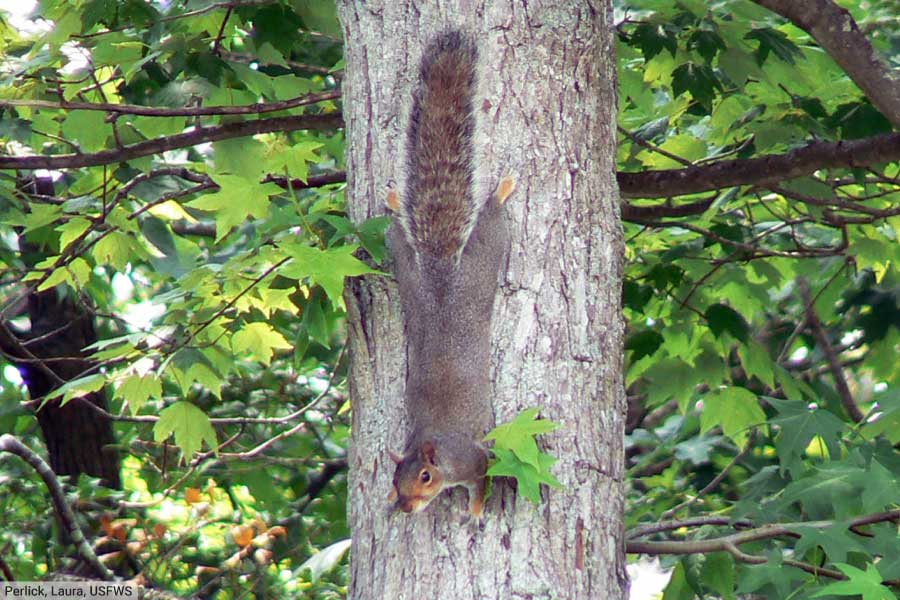
Scientific name: Sciurus carolinensis
Family: Sciuridae
Where found: Eastern North America and parts of the United Kingdom
Conservation status: Least Concern
The Eastern Gray Squirrel is a common tree squirrel known for its agility and adaptability. It is primarily herbivorous, feeding on seeds, nuts, and fruits. The species is known for its food-caching behavior, burying food in the ground to recover later.
Discover More With Active Wild
You can find out more about rodents on this page: Rodents – The Ultimate Guide
Discover different types of mammals on this page: Types of Mammals
Northern Cardinal

Scientific name: Cardinalis cardinalis
Family: Cardinalidae
Where found: Eastern and central North America, from Canada to Mexico
Conservation status: Least Concern
The Northern Cardinal is a medium-sized songbird known for its prominent crest and the vibrant red color of the male. Females are primarily brown with a reddish tint on their wings and tail.
Northern Cardinals are omnivores, feeding on seeds, fruits, and insects. They are non-migratory and can be found year-round in woodlands and other habitats within their range.
Discover More With Active Wild
You can find out more about birds on this page: Birds – The Ultimate Guide
Discover different types of birds on this page: Types of Birds
Test your knowledge of North American birds with our Android app: North American Bird ID Quiz for Android
Raccoon

Scientific name: Procyon lotor
Family: Procyonidae
Where found: North America, Central America, and parts of South America, in a wide range of habitats including forests, marshes, and urban areas
Conservation status: Least Concern
The Raccoon is a medium-sized mammal known for its distinctive black mask, bushy ringed tail, and dexterous front paws. It is a highly-adaptable animal, thriving in both rural and urban environments.
Raccoons are omnivores with a varied diet that includes fruits, nuts, insects, small mammals, birds, and amphibians. They are known for their problem-solving abilities and have been observed using their front paws to manipulate objects and open containers. Raccoons are primarily nocturnal and are often found near water sources.
Although mostly solitary, raccoons may gather in small groups to forage or den together during the winter months.
Discover More With Active Wild
You can find out more about this animal on this page: Raccoon Facts
You can see more nocturnal animals on this page: Nocturnal Animals List with Pictures & Facts
White-Tailed Deer
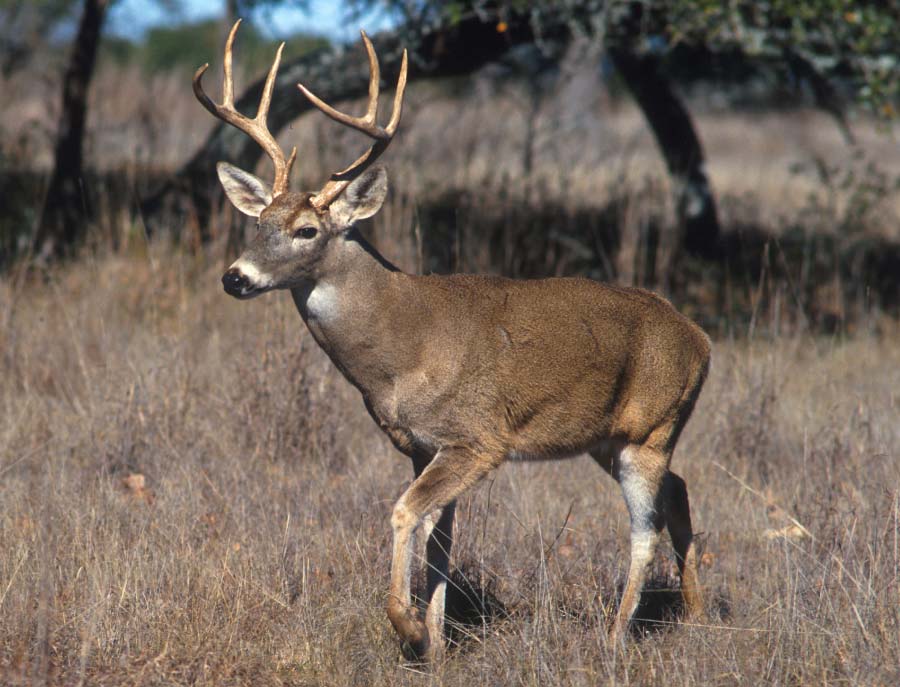
Scientific name: Odocoileus virginianus
Family: Cervidae
Where found: North, Central, and South America
Conservation status: Least Concern
The White-tailed Deer is a medium-sized deer that is widely distributed throughout the Americas. It is known for its characteristic white tail, which is raised as a warning signal when alarmed.
White-tailed deer are herbivores and have a varied diet that includes leaves, stems, fruits, and nuts.
Discover More With Active Wild
You can see more animals with antlers on this page: Animals With Antlers
Discover different types of mammals on this page: Types of Mammals
Wild Turkey

Scientific name: Meleagris gallopavo
Family: Phasianidae
Where found: North America, from Canada to Mexico
Conservation status: Least Concern
The Wild Turkey is a large ground-dwelling bird native to North America. It is known for its distinct fan-shaped tail and wattled neck.
Wild Turkeys are omnivores with a diverse diet that includes seeds, insects, and small animals. Strong fliers, they are capable of reaching speeds of up to 55 miles per hour over short distances.
Discover More With Active Wild
You can find out more about birds on this page: Birds – The Ultimate Guide
Discover different types of birds on this page: Types of Birds
Test your knowledge of North American birds with our Android app: North American Bird ID Quiz for Android
Woodland Animals of Europe
Eurasian Lynx
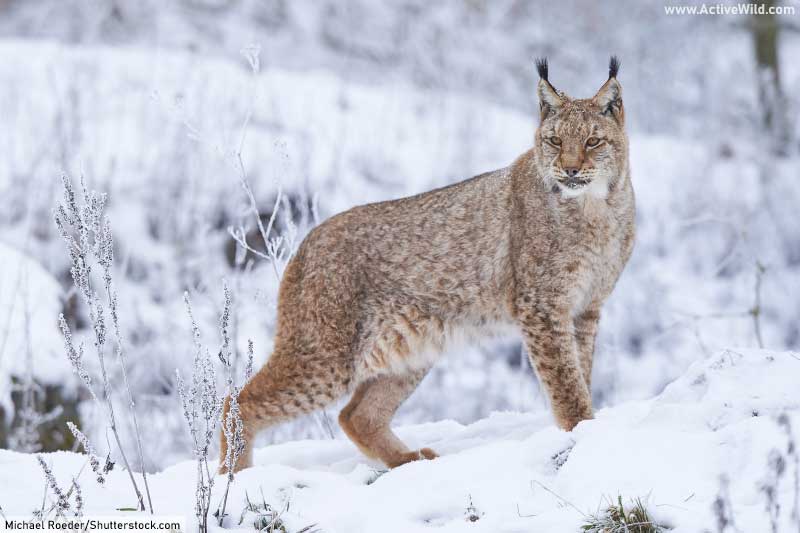
Scientific name: Lynx lynx
Family: Felidae
Where found: Europe and Asia
Conservation status: Least Concern
The Eurasian Lynx is the largest of the four species of lynx and is characterized by its powerful build, short tail, and tufted ears.
This wild cat is a solitary, elusive predator that primarily hunt ungulates such as deer, but will also consume smaller mammals and birds.
The Eurasian Lynx has excellent climbing abilities and is known for its stealth and agility.
Discover More With Active Wild
You can find out more about this animal on this page: Eurasian Lynx Facts
You can see EVERY species of cat on this page: Wild Cats Species List with Pictures and Facts
European Badger
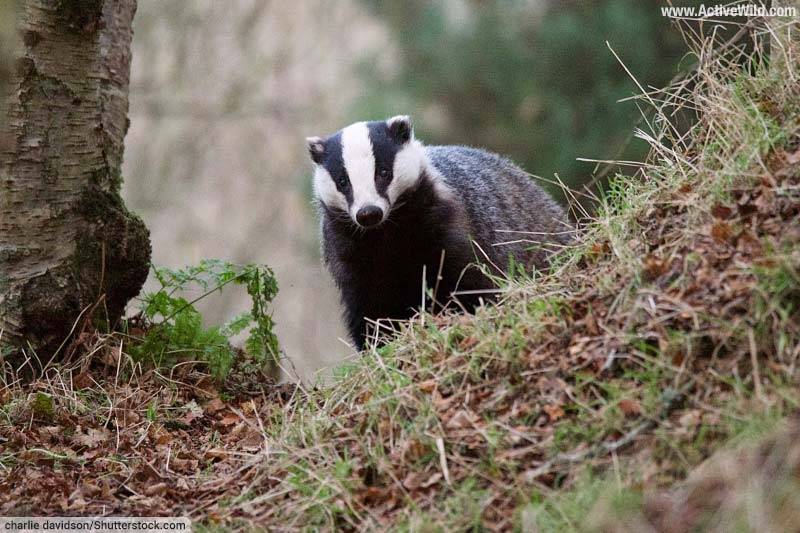
Scientific name: Meles meles
Family: Mustelidae
Where found: Europe and parts of Asia
Conservation status: Least Concern
One of the best-known of all European woodland animals, the European Badger is a medium-sized, nocturnal mammal characterized by its stocky build and distinctive black and white-striped face.
The European badger is an omnivore whose varied diet includes earthworms, insects, fruits, and small mammals.
European Badgers live in complex burrow systems called setts, which they share with other badgers in social groups known as clans.
Discover More With Active Wild
You can see more nocturnal animals on this page: Nocturnal Animals List with Pictures & Facts
You can see more black and white animals on this page: Black and White Animals
European Hedgehog
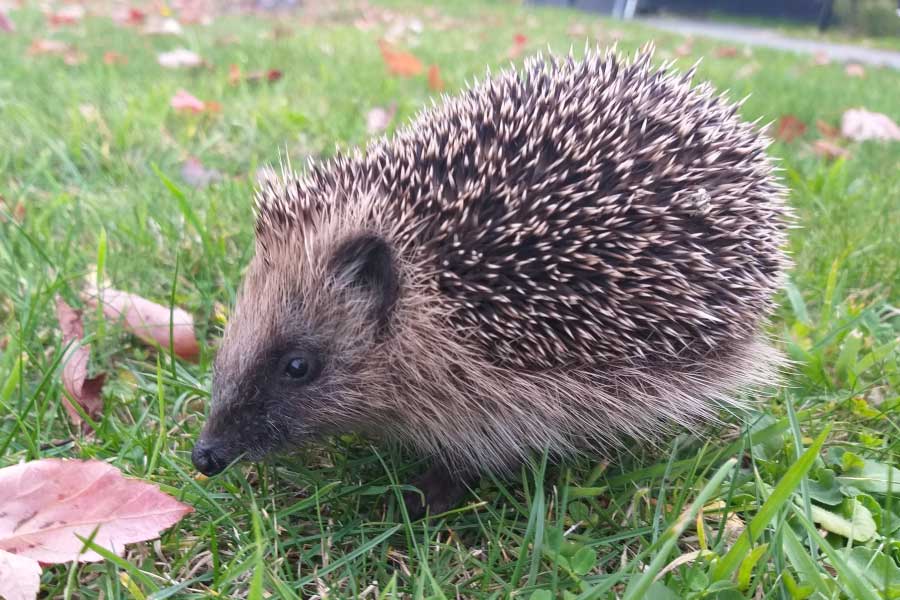
Scientific name: Erinaceus europaeus
Family: Erinaceidae
Where found: Western Europe and parts of Scandinavia
Conservation status: Least Concern
The European Hedgehog is a small, nocturnal mammal known for its distinctive coat of spines. When threatened, it curls into a tight ball to protect its vulnerable underside.
European Hedgehogs are primarily insectivores, feeding on a variety of invertebrates such as beetles, earthworms, and slugs. They also occasionally consume fruits and fungi.
Discover More With Active Wild
You can see more animals that hibernate on this page: Animals That Hibernate
You can see more nocturnal animals on this page: Nocturnal Animals List with Pictures & Facts
European Wild Boar
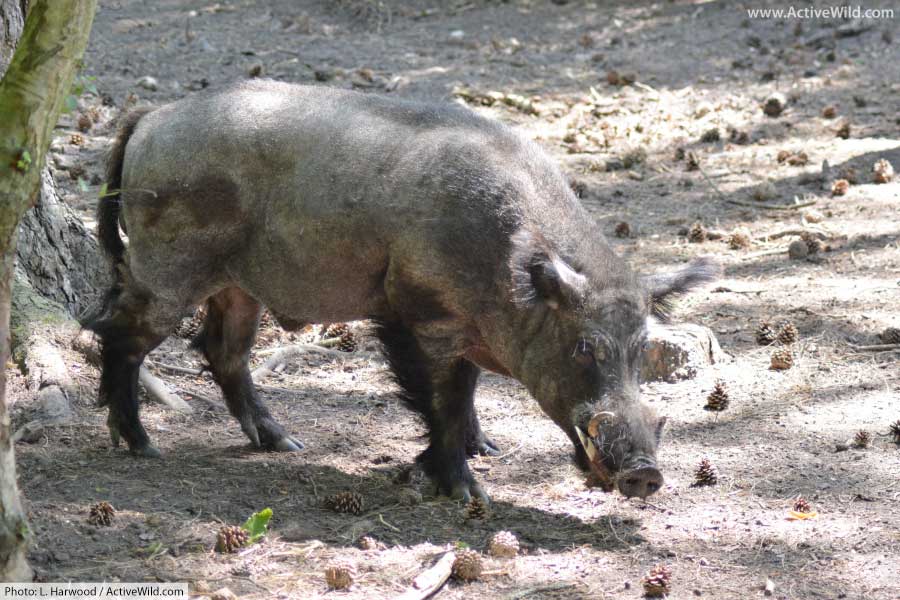
Scientific name: Sus scrofa
Family: Suidae
Where found: Europe, Asia, and North Africa
Conservation status: Least Concern
The European Wild Boar is a large, robust mammal with a thick, bristly coat and, in many regions, a distinct mane.
This large woodland animal is the wild ancestor of domestic pigs and is known for its sharp tusks and acute sense of smell.
European Wild Boars are omnivores, consuming a varied diet that includes roots, tubers, fruits, small mammals, and carrion. Females and young boars are social, typically living in groups called sounders. Adult males are more solitary.
Discover More With Active Wild
You can see more omnivorous animals on this page: Omnivores Examples
Great Spotted Woodpecker
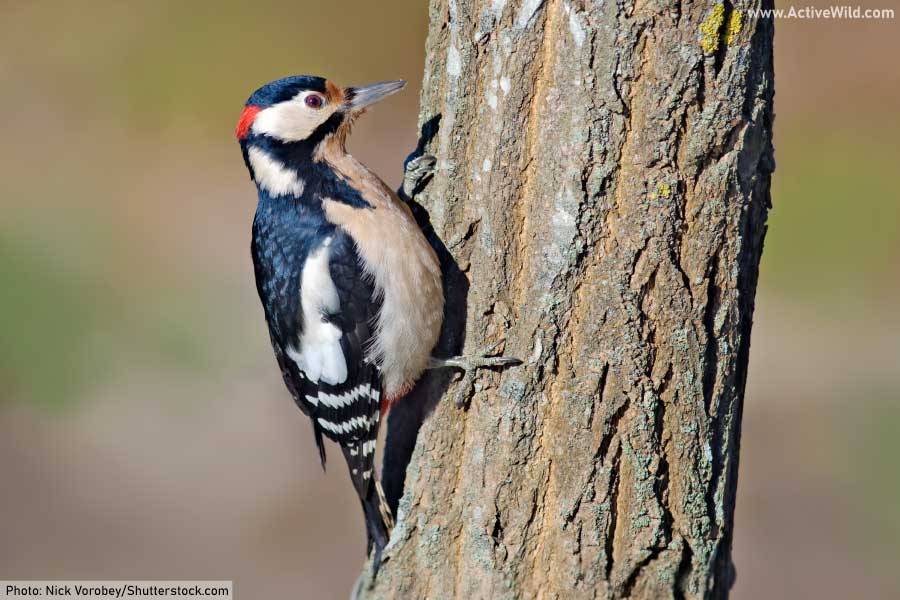
Scientific name: Dendrocopos major
Family: Picidae
Where found: Europe and northern Asia, in woodlands, forests, and parks
Conservation status: Least Concern
The Great Spotted Woodpecker is a medium-sized woodpecker characterized by its black and white plumage, with males having a distinctive red patch on the nape of their necks. Both sexes have a red undertail.
The species uses its strong bill for drilling holes in trees to find insects and larvae. It is known for its drumming behavior, which consists of rapid pecking on tree trunks or branches, used as a form of communication and territory defense.
The Great Spotted Woodpecker’s diet consists mainly of insects, but also includes seeds, nuts, and occasionally the eggs and chicks of other birds.
Great Spotted Woodpeckers are generally solitary, coming together only for breeding purposes.
Discover More With Active Wild
Test your knowledge of British birds with our Android app: British Bird ID Quiz for Android
You can see a list of British birds on this page: Common British Birds
Red Fox
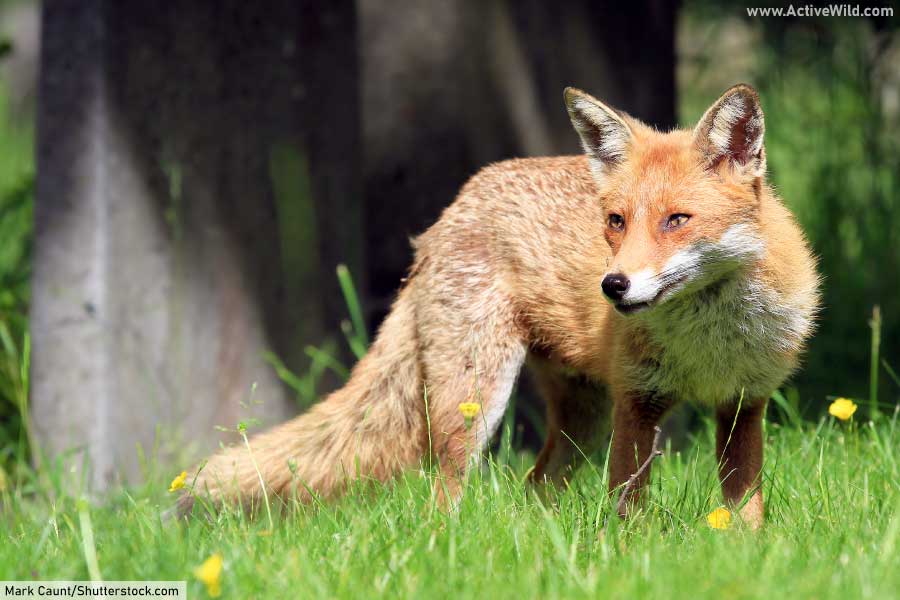
Scientific name: Vulpes vulpes
Family: Canidae
Where found: Across the Northern Hemisphere, including North America, Europe, Asia, and northern Africa
Conservation status: Least Concern
The Red Fox is the largest species of the genus Vulpes (members of this group are known as “true foxes”) and is known for its reddish-brown fur, bushy tail, and distinctive white tip on the tail.
An adaptable and opportunistic predator, the red fox’s diet includes small mammals, birds, insects, and fruits.
Red foxes are known for their intelligence, resourcefulness, and adaptability. Despite being a woodland animal, it is also seen in a variety of other habitats, including towns and cities.
Discover More With Active Wild
You can see EVERY species of dog (including foxes) on this page: Wild Dog Species List with Pictures and Facts
Woodland Animals of Africa
African Civet
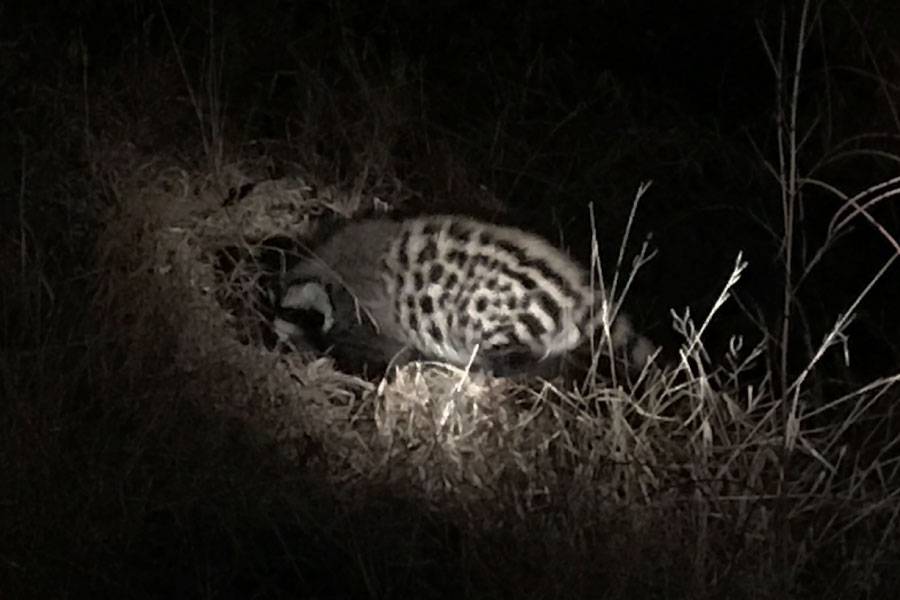
Scientific name: Civettictis civetta
Family: Viverridae
Where found: Sub-Saharan Africa
Conservation status: Least Concern
The African Civet is a nocturnal mammal characterized by its distinctive black and white markings and a raccoon-like facial mask.
This woodland animal is known for producing a musky secretion called civetone, which has been used in the perfume industry.
The African Civet is an omnivore, feeding on insects, small mammals, fruits, and carrion.
Discover More With Active Wild
You can see more black and white animals on this page: Black and White Animals
You can see more nocturnal animals on this page: Nocturnal Animals List with Pictures & Facts
African Forest Elephant
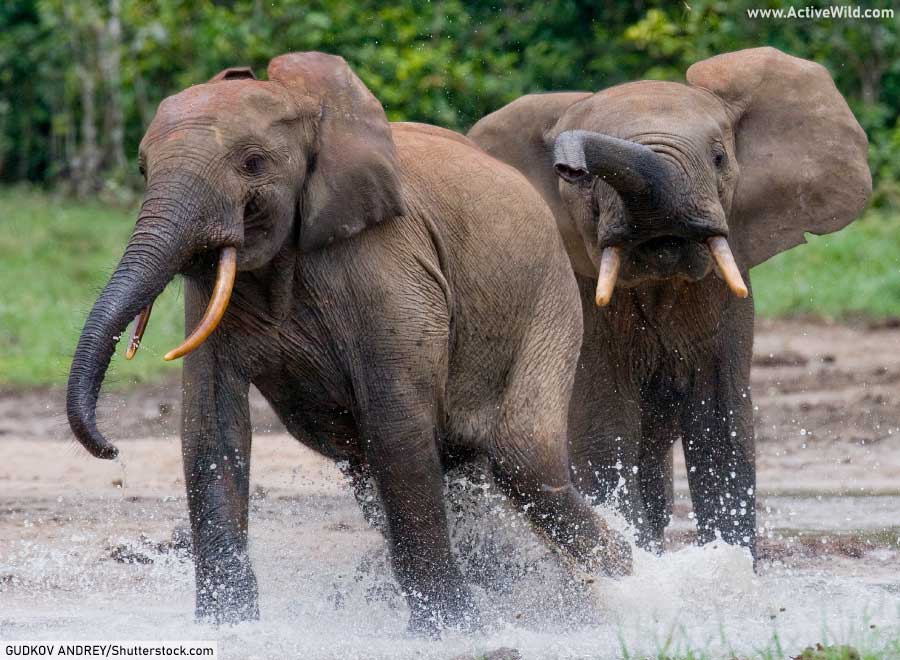
Scientific name: Loxodonta cyclotis
Family: Elephantidae
Where found: Central and West African rainforests
Conservation status: Critically Endangered
The African Forest Elephant is the smallest of the three living elephant species, and one of two African elephant species (the other being the African bush elephant). It lives in forests and woodlands in West Africa.
African Forest Elephants are herbivores, consuming a diet primarily consisting of leaves, fruits, and bark from trees. They play a vital role in seed dispersal and maintaining the health of their forest habitat.
Discover More With Active Wild
Find out more about endangered elephants: Endangered Elephants
You can see more critically endangered animals on this page: Critically Endangered Species
African Wild Dog
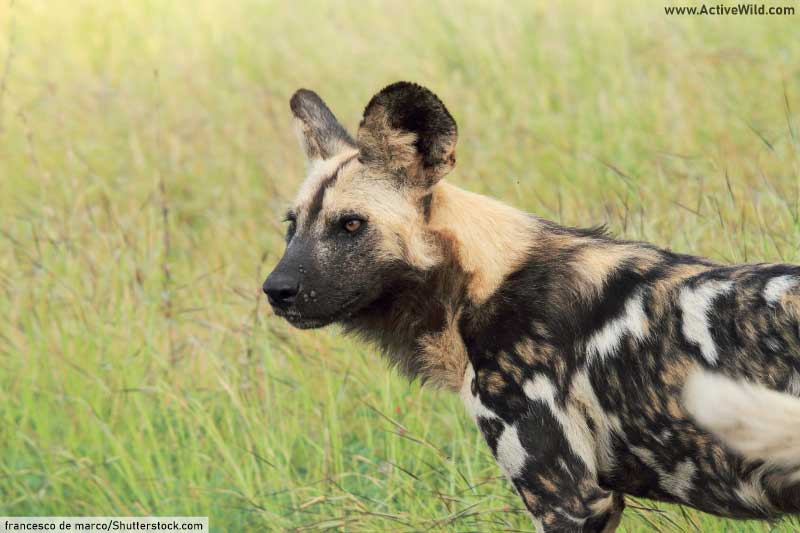
Scientific name: Lycaon pictus
Family: Canidae
Where found: Sub-Saharan Africa, primarily in savannas and grasslands
Conservation status: Endangered
The African Wild Dog, also known as the Painted Dog, is an African canid (member of the dog family, Canidae) with a uniquely-patterned coat.
A highly social canid species, the African Wild Dog is known to regurgitate its food not only for infants, but also for other adult members of its pack.
African Wild Dogs live in packs and are cooperative hunters, primarily preying on medium-sized ungulates. They are known for their high hunting success rate compared to other large predators.
Discover More With Active Wild
You can see more endangered animals on this page: Endangered Animals
You can see EVERY species of dog on this page: Wild Dog Species List with Pictures and Facts
Chimpanzee

Scientific name: Pan troglodytes
Family: Hominidae
Where found: Sub-Saharan Africa, in a range of habitats including tropical forests, savannas, and woodland
Conservation status: Endangered
Chimpanzees are highly intelligent and social primates, closely related to humans. They are known for their tool use, complex vocalizations, and intricate social structures. Chimpanzees have a diverse diet, including fruits, leaves, insects, and occasionally small mammals. They are also known for their hunting behavior, often cooperatively hunting smaller primates such as colobus monkeys.
Discover More With Active Wild
You can see more endangered animals on this page: Endangered Animals
You can find out more about primates on this page: Primates – Ultimate Guide
Serval
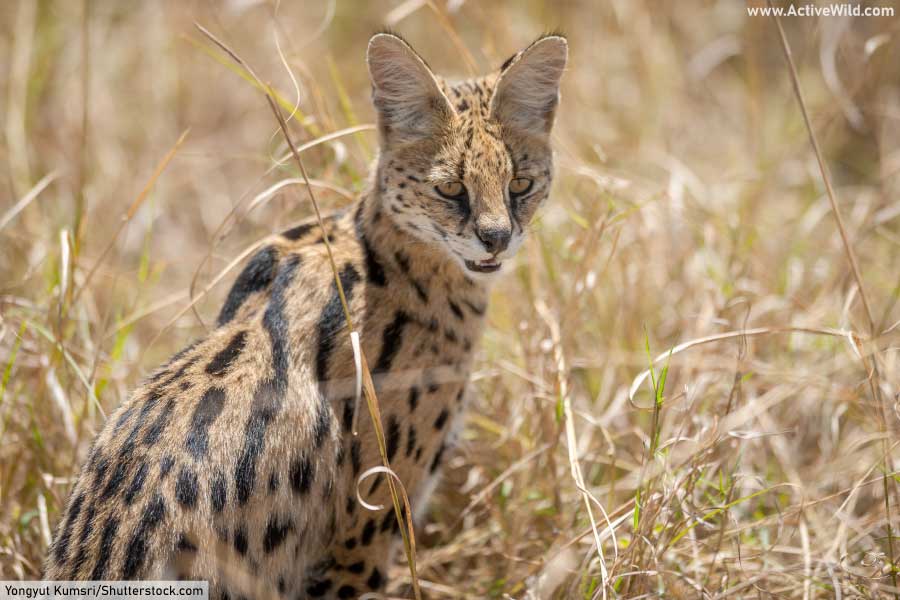
Scientific name: Leptailurus serval
Family: Felidae
Where found: Africa, particularly in savannas and grasslands near water sources
Conservation status: Least Concern
The Serval is a medium-sized wild cat known for its slender build, long legs, large ears, and distinctive spotted and striped coat. These adaptations make the Serval an agile and efficient predator, particularly in tall grasses.
The serval has a diverse diet, primarily consisting of rodents, birds, and small mammals.
Servals are solitary animals and have a wide range of vocalizations, including purrs, growls, and high-pitched cries. They are skilled hunters with an impressive success rate, using their keen hearing to locate prey and their powerful hind legs to leap and pounce.
Discover More With Active Wild
You can see EVERY species of cat on this page: Wild Cats Species List with Pictures and Facts
Woodland Animals of Asia
Asian Black Bear
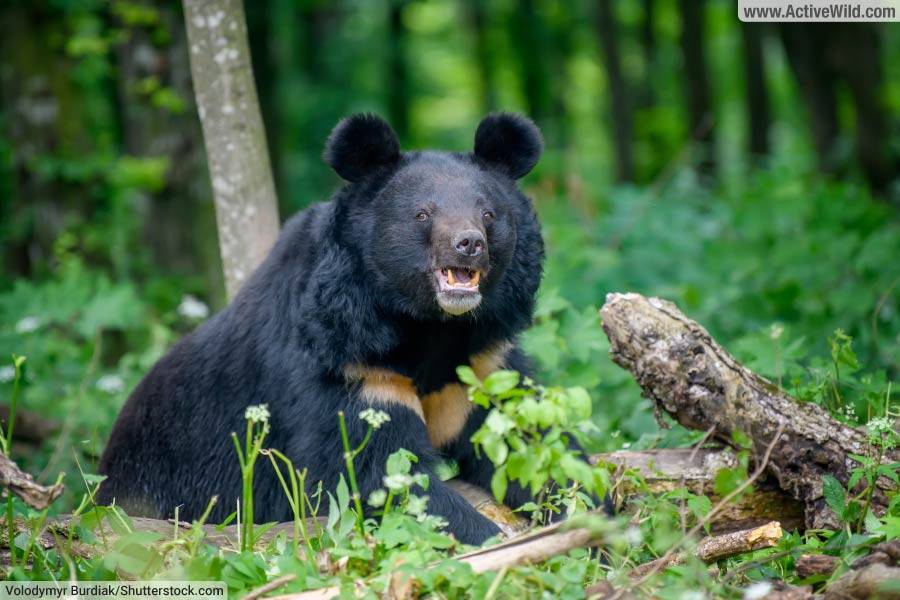
Scientific name: Ursus thibetanus
Family: Ursidae
Where found: Southeastern Asia, eastern Russia, the Korean Peninsula, and Japan
Conservation status: Vulnerable
The Asian Black Bear, also known as the Moon Bear, is a medium-sized bear species known for its distinct white, crescent-shaped marking on the chest. The species is omnivorous, with a diet of fruits, insects, small mammals, and plant material.
An excellent climber, the Asian Black Bear spends a significant amount of time in trees.
Discover More With Active Wild
You can find out more about bears on this page: Bears – The Ultimate Guide
Discover all eight types of bear on this page: Types of Bears
Indian Giant Squirrel
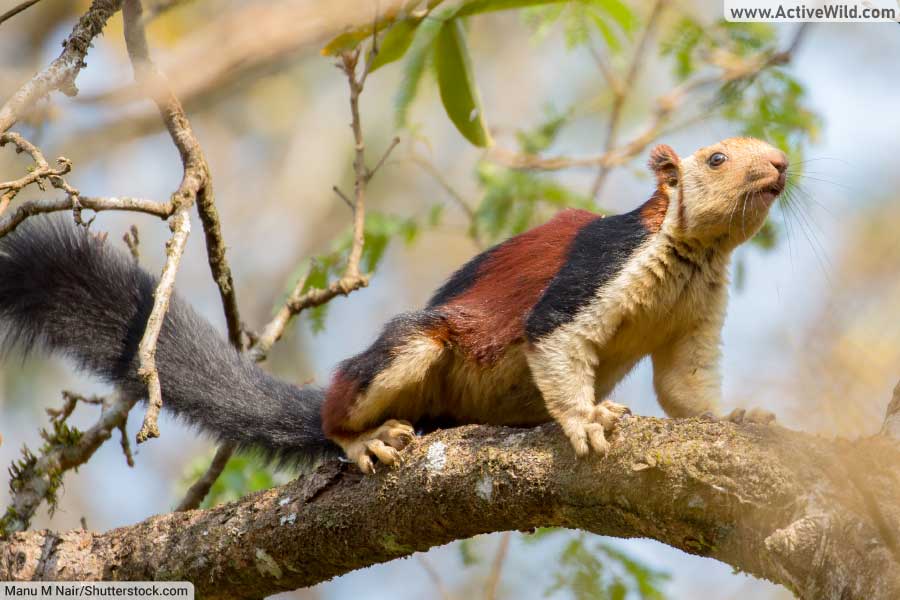
Scientific name: Ratufa indica
Family: Sciuridae
Where found: India, particularly in deciduous and evergreen forests
Conservation status: Least Concern
The Indian Giant Squirrel, also known as the Malabar Giant Squirrel, is a large tree squirrel species known for its vivid coloration, which can range from shades of red to black.
This woodland animal spends most of its life in the forest canopy. It is herbivorous, feeding primarily on fruits, nuts, and flowers.
Discover More With Active Wild
You can find out more about rodents on this page: Rodents – The Ultimate Guide
Indian Peafowl
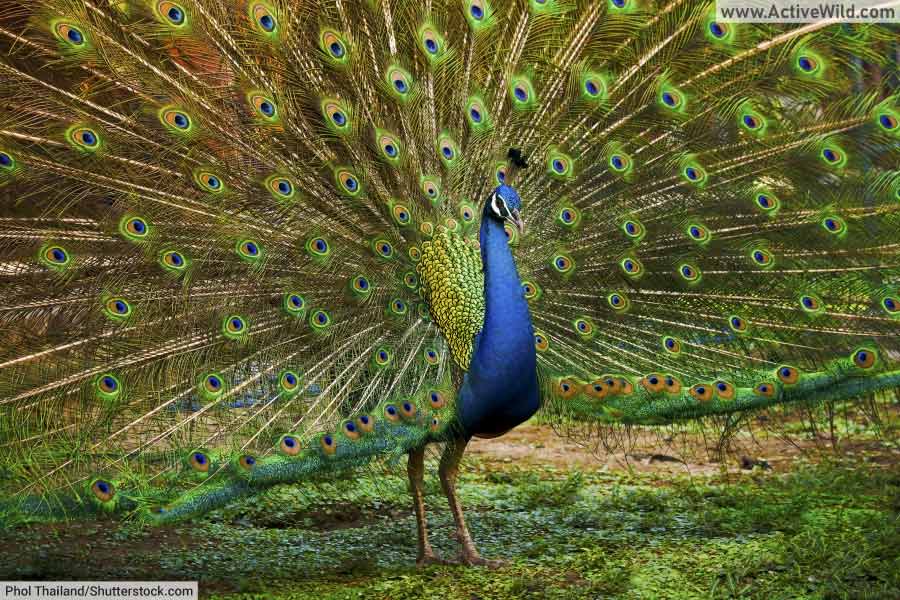
Scientific name: Pavo cristatus
Family: Phasianidae
Where found: India, Pakistan, Bangladesh, and Sri Lanka
Conservation status: Least Concern
The Indian Peafowl, commonly known as the Peacock, is a large and colorful bird species known for the extravagant display of the male’s iridescent plumage. The male’s long, fan-like tail feathers are used during courtship displays.
Indian Peafowls are omnivorous, consuming a diet of seeds, fruits, insects, and small mammals.
Discover More With Active Wild
You can find out more about birds on this page: Birds – The Ultimate Guide
Discover different types of birds on this page: Types of Birds
Japanese Serow
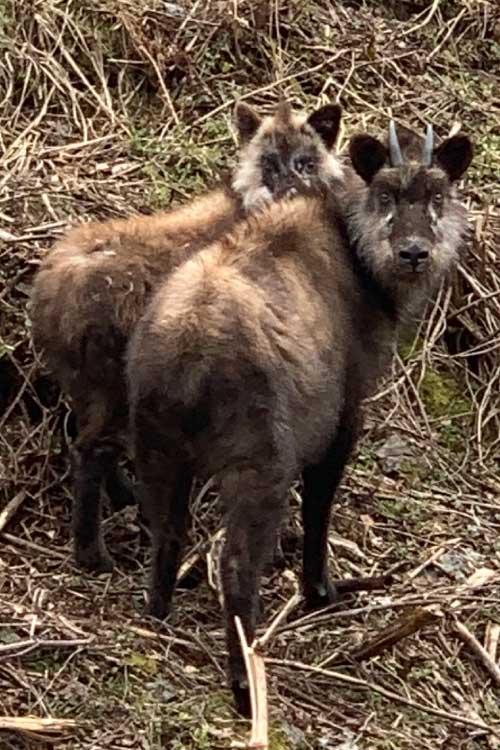
Scientific name: Capricornis crispus
Family: Bovidae
Where found: Japan, in mountainous areas and dense forests
Conservation status: Least Concern
The Japanese Serow is a small, goat-like ungulate found in Japan’s mountainous regions. It has a thick coat of fur, which can vary in color from brown to black, and both sexes have short, backward-curving horns.
Japanese Serows are herbivorous, feeding on leaves, twigs, and bark from trees and shrubs.
Discover More With Active Wild
You can see more herbivorous animals on this page: Herbivores Examples
You can see more horned animals on this page: Animals With Horns
Leopard

Scientific name: Panthera pardus
Family: Felidae
Where found: Africa, Asia, and the Middle East
Conservation status: Vulnerable
The Leopard is a large, elusive cat species known for its rosette-patterned coat and adaptability to various habitats, from woodlands to rainforests.
Leopards are solitary predators and are known for their incredible strength, often dragging prey weighing more than their own body weight up into trees.
The diet of this carnivorous animal includes ungulates, primates, and small mammals.
Discover More With Active Wild
You can see EVERY species of cat on this page: Wild Cats Species List with Pictures and Facts
Woodland Animals of Australia
Common Brushtail Possum
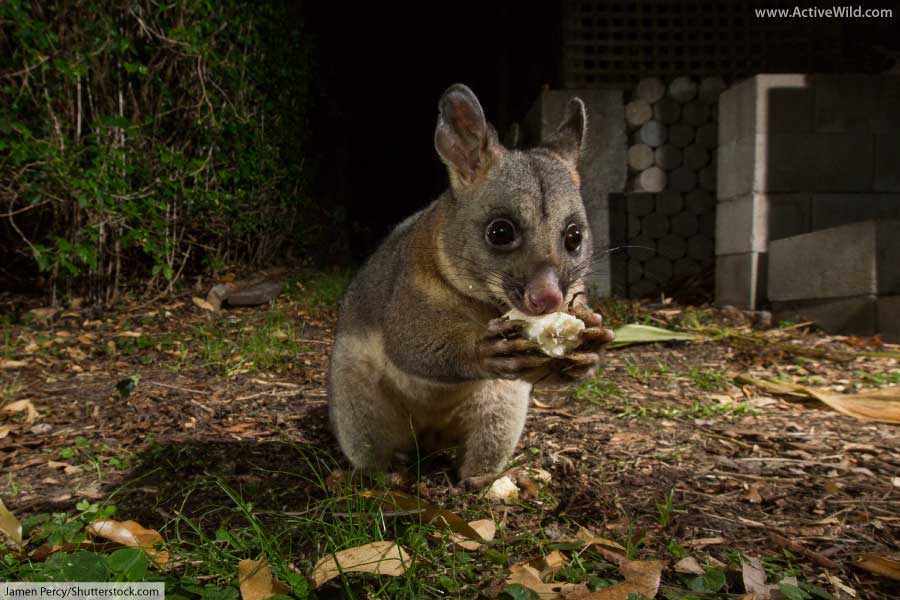
Scientific name: Trichosurus vulpecula
Family: Phalangeridae
Where found: Australia, Tasmania, and New Zealand
Conservation status: Least Concern
The Common Brushtail Possum is a nocturnal marsupial with a bushy tail and a thick, grayish-brown coat. It is arboreal (tree-dwelling) and primarily herbivorous, feeding on leaves, fruits, and flowers. (From time to time, it may also consume small insects and birds’ eggs.)
Common Brushtail Possums are known for their adaptability, thriving in both urban and rural environments.
Discover More With Active Wild
You can see more marsupials on this page: Types of Marsupials
You can see more nocturnal animals on this page: Nocturnal Animals List with Pictures & Facts
Eastern Grey Kangaroo
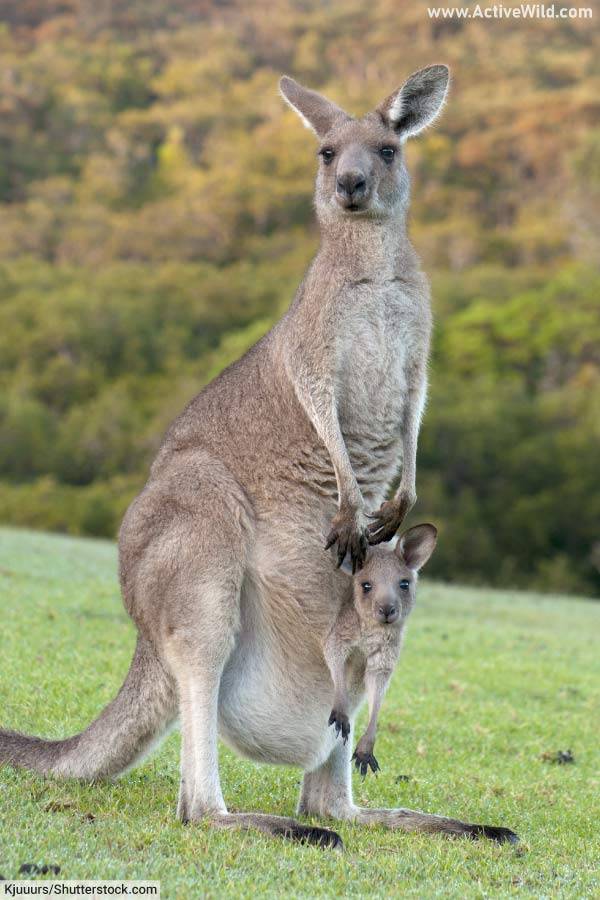
Scientific name: Macropus giganteus
Family: Macropodidae
Where found: Eastern Australia, in habitats such as forests, woodlands, and grasslands
Conservation status: Least Concern
The eastern grey kangaroo is the world’s second-largest living marsupial; only the red kangaroo is larger. It is found in woodlands and a variety of other habitats across much of east Australia. The species looks very similar to the closely-related western grey kangaroo.
Using its powerful hind legs, the eastern grey kangaroo can reach speeds of up to 64 km/h (40 mph) – the fastest recorded speed of any kangaroo.
The eastern grey kangaroo is herbivorous, primarily grazing on grasses. A social animal, it lives in groups called mobs or troops, which can include up to several dozen individuals.
Like other kangaroo species, eastern grey kangaroo mothers carry their young, called joeys, in a pouch.
Discover More With Active Wild
You can see more marsupials on this page: Types of Marsupials
You can find out more about kangaroos on this page: Kangaroo Facts
Koala

Scientific name: Phascolarctos cinereus
Family: Phascolarctidae
Where found: Eastern Australia, in eucalyptus forests
Conservation status: Vulnerable
Koalas are arboreal marsupials known for their thick, gray fur and rounded ears. They have a specialized diet, feeding almost exclusively on eucalyptus leaves.
Koalas have a low metabolic rate and spend a significant amount of time sleeping to conserve energy. They are often incorrectly referred to as “koala bears” due to their bear-like appearance, but they are not related to bears.
Discover More With Active Wild
You can find out more about this animal on this page: Koala Facts
You can see more marsupials on this page: Types of Marsupials
Laughing Kookaburra
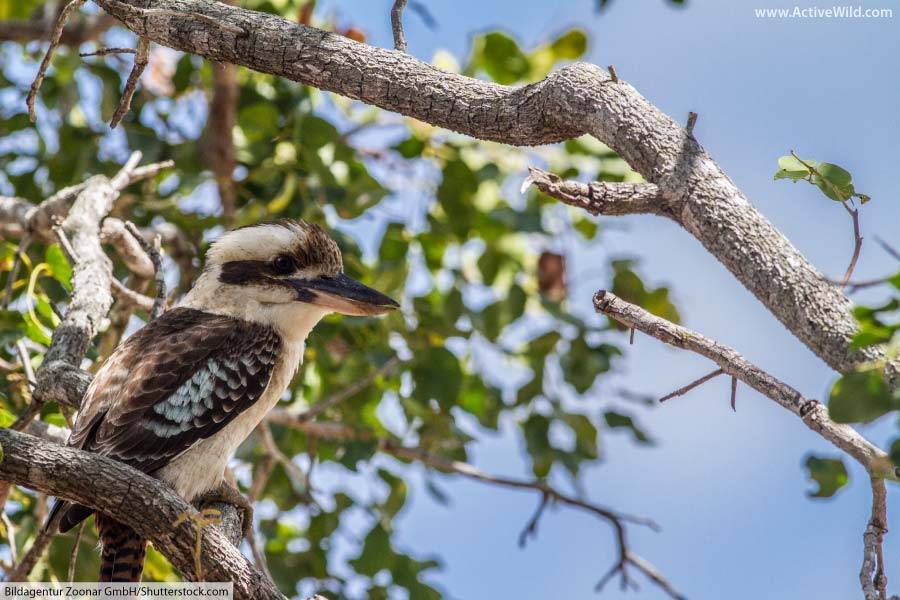
Scientific name: Dacelo novaeguineae
Family: Alcedinidae
Where found: Eastern and southeastern Australia, in eucalypt forests, woodlands, and urban areas
Conservation status: Least Concern
The Laughing Kookaburra is the largest species in the kingfisher family Alcedinidae. It is known for its iconic “laughing” call, which sounds like human laughter.
This Australian woodland bird has a stocky build, a large head, and a robust bill. It is carnivorous, feeding on a variety of prey, including insects, small mammals, reptiles, and other birds.
The Laughing Kookaburra is territorial, often living in family groups, and is known to engage in cooperative breeding, with offspring from previous years helping to raise new chicks.
Discover More With Active Wild
You can find out more about this animal on this page: Kookaburra Facts
You can see more carnivorous animals on this page: Carnivores Examples
Tasmanian Devil
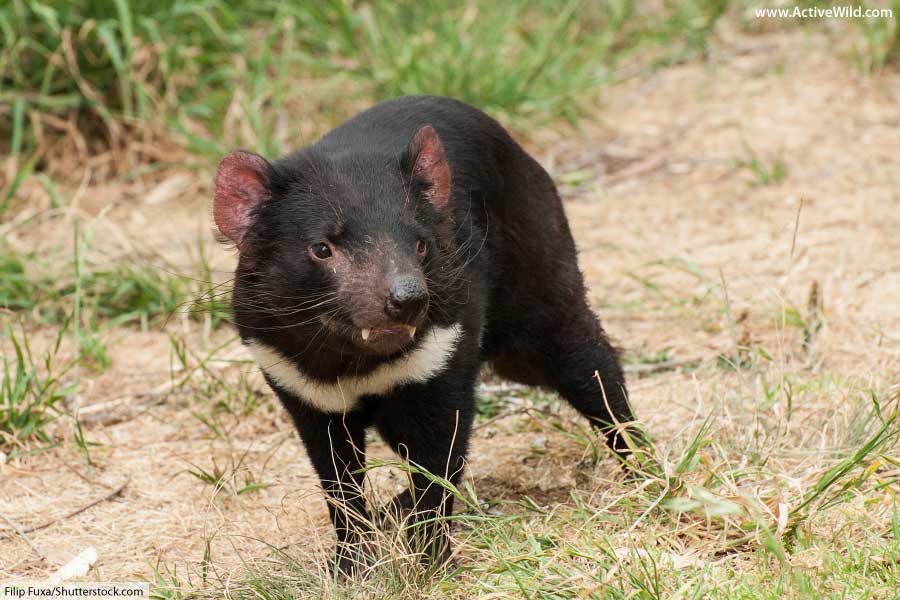
Scientific name: Sarcophilus harrisii
Family: Dasyuridae
Where found: Tasmania
Conservation status: Endangered
The Tasmanian Devil is a small, nocturnal carnivorous marsupial known for its ferocious demeanor and powerful bite. It has a muscular build, black fur, and a distinctive white marking on the chest.
Tasmanian Devils are primarily scavengers, feeding on carrion, but they will also hunt small mammals, birds, and reptiles. They are currently endangered due to a contagious facial tumor disease that has significantly impacted their population.
Discover More With Active Wild
You can see more carnivorous animals on this page: Carnivores Examples
You can see more marsupials on this page: Types of Marsupials
Woodland Animals of South America
Capybara
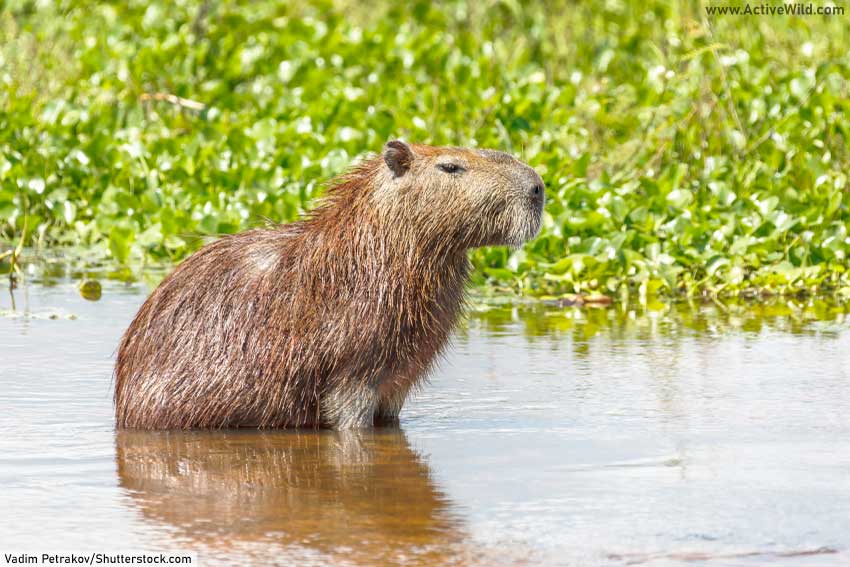
Scientific name: Hydrochoerus hydrochaeris
Family: Caviidae
Where found: South America, in areas near water bodies such as rivers and swamps
Conservation status: Least Concern
The Capybara is the world’s largest rodent, and has a barrel-shaped body and short limbs. A semi-aquatic animal, it is an excellent swimmer and always found near water.
Capybaras are herbivores, primarily grazing on grasses and aquatic plants. They live in large social groups.
Discover More With Active Wild
You can find out more about rodents on this page: Rodents – The Ultimate Guide
Giant Anteater
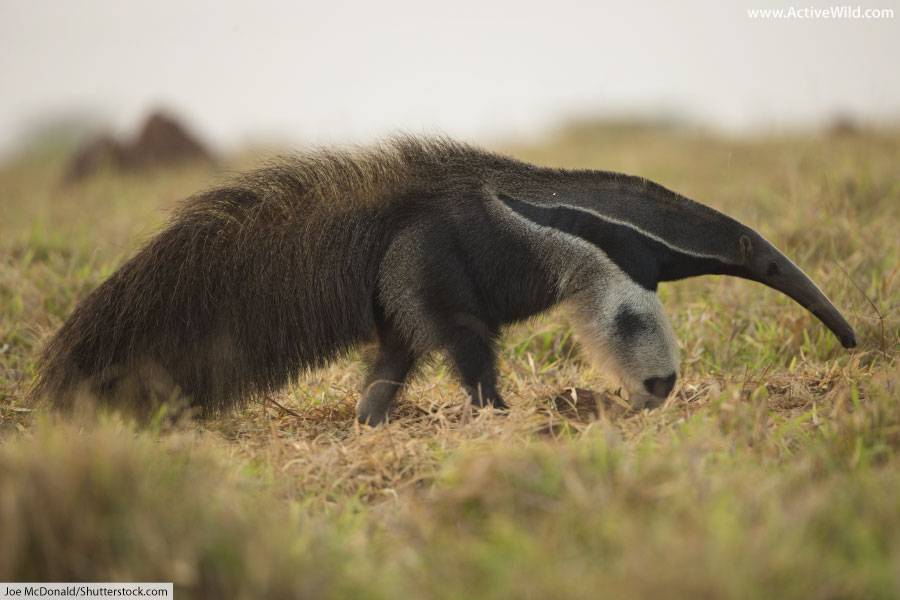
Scientific name: Myrmecophaga tridactyla
Family: Myrmecophagidae
Where found: Central and South America, in habitats ranging from grasslands to rainforests
Conservation status: Vulnerable
The Giant Anteater is a unique mammal known for its elongated snout, bushy tail, and long, sticky tongue, which it uses to consume ants and termites. The species has a keen sense of smell to locate insect colonies and powerful front claws to dig out its prey.
Giant Anteaters are solitary animals with a low metabolic rate, spending much of their time resting.
Discover More With Active Wild
You can find out more about this animal on this page: Giant Anteater Facts
Discover more about anteaters on this page: Anteater Facts
Jaguar

Scientific name: Panthera onca
Family: Felidae
Where found: Central and South America, primarily in rainforests and swamps
Conservation status: Near Threatened
The Jaguar is the largest cat species in the Americas and is known for its powerful build and striking, rosette-patterned coat. They are skilled swimmers and climbers and are highly adaptable to various habitats. Jaguars are apex predators, hunting a wide variety of prey, including caimans, capybaras, and deer. They have an exceptionally strong bite, capable of crushing the skulls of their prey.
Discover More With Active Wild
You can find out more about this animal on this page: Jaguar Facts
You can see EVERY species of cat on this page: Wild Cats Species List with Pictures and Facts
Scarlet Macaw
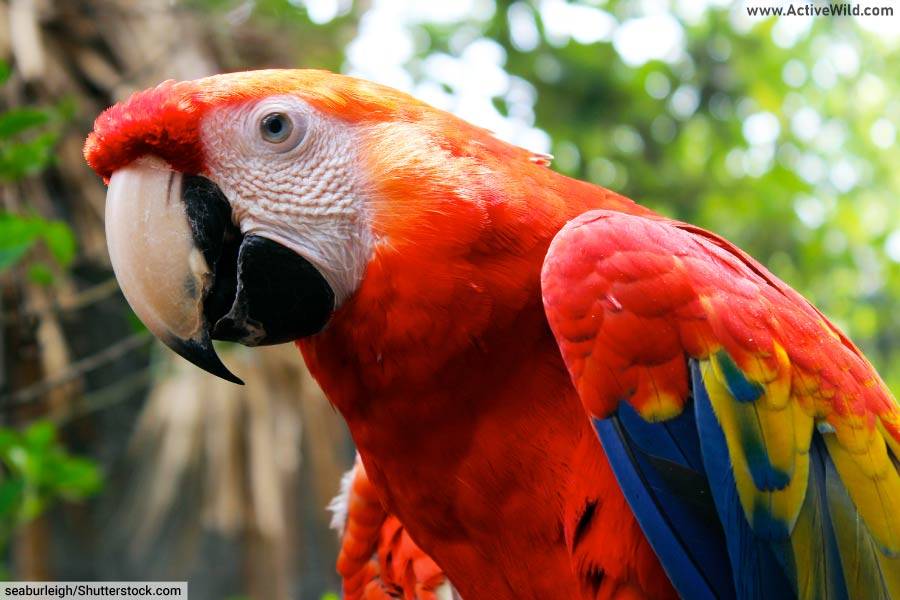
Scientific name: Ara macao
Family: Psittacidae
Where found: Central and South America, in rainforests and savannas
Conservation status: Least Concern
The Scarlet Macaw is a large, brightly colored parrot known for its vibrant red, blue, and yellow plumage. They have strong beaks, which they use for cracking nuts and seeds, and zygodactyl feet, with two toes facing forward and two facing backward, which help them climb and grasp objects. Scarlet Macaws are highly intelligent and social birds, often living in pairs or small groups.
Discover More With Active Wild
You can find out more about birds on this page: Birds – The Ultimate Guide
Discover different types of birds on this page: Types of Birds
Yellow-Footed Tortoise
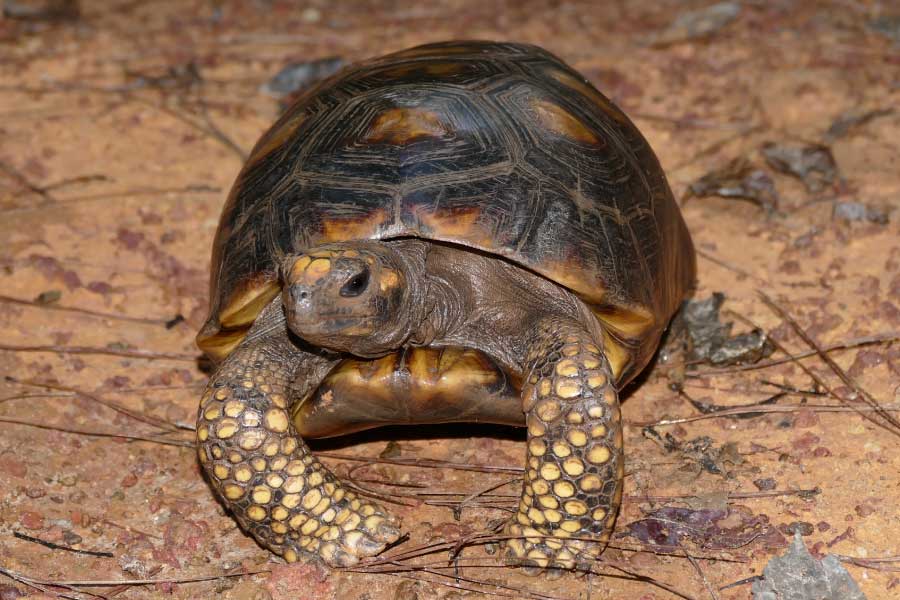
Scientific name: Chelonoidis denticulatus
Family: Testudinidae
Where found: South America, in rainforests, wooded areas and savannas of the Amazon Basin
Conservation status: Vulnerable
The Yellow-footed Tortoise, also known as the Brazilian Giant Tortoise, is a large species of tortoise known for the distinct yellow-orange markings on its legs, head, and the edges of its carapace.
Yellow-footed Tortoises are herbivores, primarily consuming a diet of leaves, fruits, flowers, and occasionally fungi. They are generally solitary animals, with males engaging in combat for access to females during the breeding season. The Yellow-footed Tortoise’s conservation status is vulnerable, with habitat loss and collection for the pet trade and consumption being the primary threats to their population.
Discover More With Active Wild
You can find out more about reptiles on this page: Reptiles – The Ultimate Guide
Discover different types of reptiles on this page: Types of Reptiles
Discover different types of turtles on this page: Types of Turtles
Discover More With Active Wild
- Become an animal expert! Animals – The Ultimate Guide To The Animal Kingdom
- You can find out more about the different types of animals on this page: Types of Animals
- You can see more African animals on this page: African Animals
- You can see more Asian animals on this page: Asian Animals
- You can see more Australian animals on this page: Australian Animals
- You can see more European animals on this page: European Animals
- You can see more North American animals on this page: North American Animals
The post Woodland Animals: List With Pictures & Interesting Facts appeared first on Active Wild.